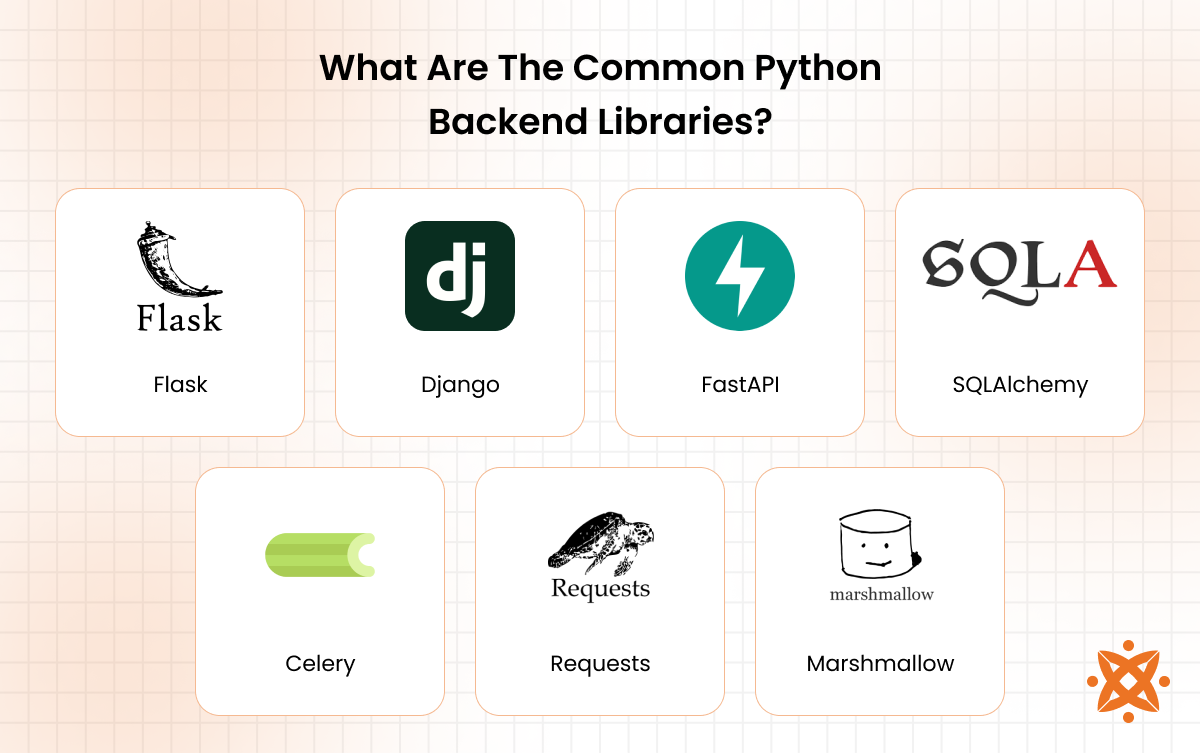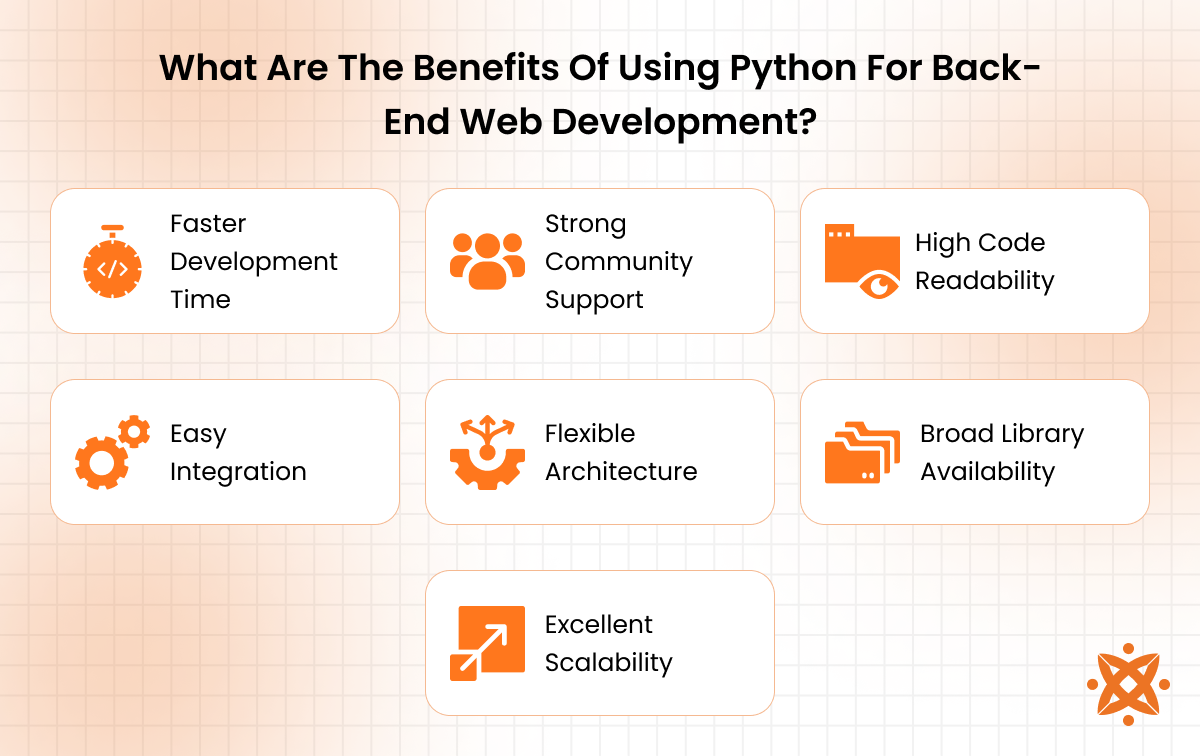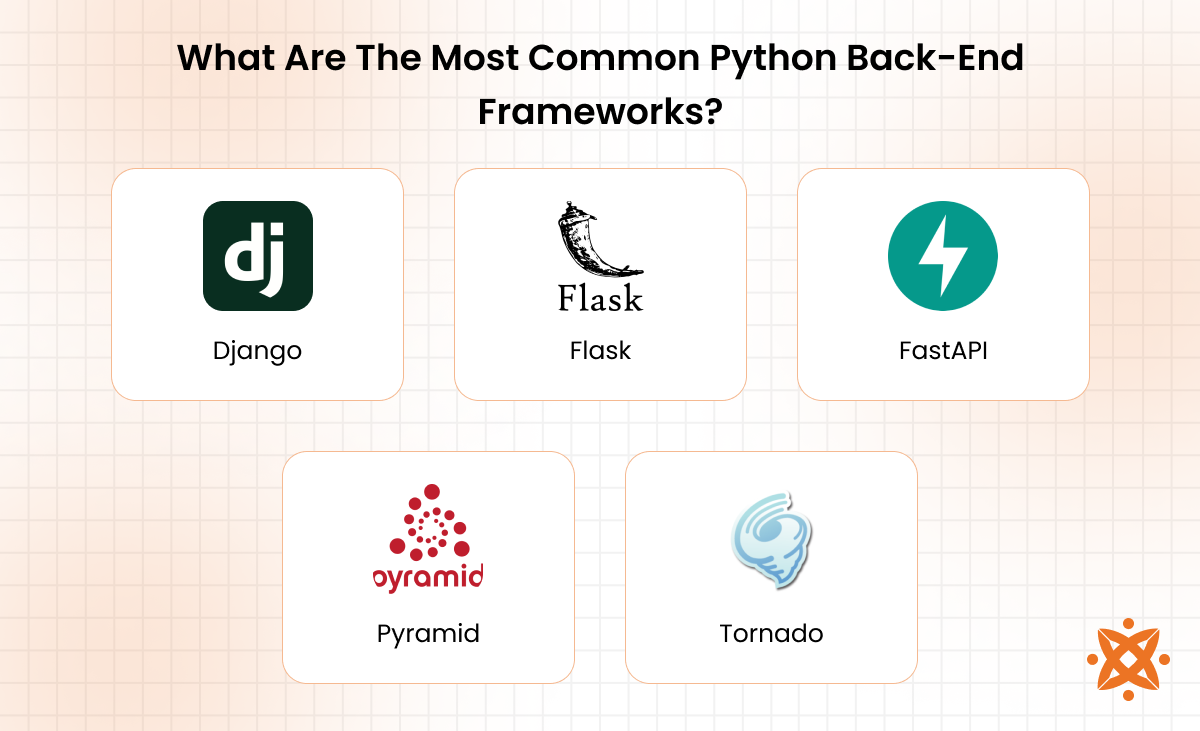
Python is used in backend web development because it helps you build, structure, and integrate complex server-side systems with less code and greater clarity.
The main primary benefits of using Python for back-end web development include faster development time, high code readability, strong community support, smooth integration, flexible architecture, a wide range of libraries, and dependable scalability.
While Python is used for front-end web development through tools like Brython or Pyodide, it's not browser-native like JavaScript, HTML, or CSS. You face performance limits, reduced compatibility, and weaker ecosystem support on the front-end.
According to the TIOBE Index (2025), Python held a 25.87% share of global developer interest, more than double that of its nearest competitor, C++, at 10.68%.
When hiring a backend web development company, consider their experience with full-stack systems, the frameworks they use, and their ability to write clean, secure, and scalable code.
Intelivita stands out as the best choice for backend web development across the UK, USA, Canada, Australia, and India. Whether you need a dedicated backend developer or a full-stack team, Intelivita delivers customised, production-ready solutions for any industry.
Why Is Python Primarily Used For Back-End Development?
Python is primarily used for backend development for the following reasons: server-sidescriptingefficiency,cleanlogicprocessing,simplified APIbuilding,extensivelibrarysupport,rapidgrowth,scalabilityforhigh-trafficapps,andsmooth integration with databases. These qualities make it dependable for managing backend logic, handling data flow, and serving dynamic web content.
Python is primarily used for backend development because of the following reasons:
- Server-side scripting is efficient and easy to manage in Python: You use fewer lines of code to process requests and manage server responses. This makes backend workflows simpler to build and maintain. It also reduces the learning curve if you're switching from frontend to backend roles.
- Logic processing in Python supports modular design and fast execution: You structure your code into functions, classes, and modules without excessive complexity. This helps you update backend logic without affecting the rest of the application. Python also works well with algorithm-intensive processes, such as search and filtering.
- API building is faster with Python frameworks like Flask, Django, and FastAPI: These frameworks let you set up endpoints, parse data, and return responses using just a few function calls. You don't need to build features like routing or error handling from scratch. That means more time focusing on features that matter.
- Library support covers every backend task: You gain access to thousands of packages for authentication, email sending, file processing, and more. Tools like `Requests`, `SQLAlchemy`, and `Celery` save you time and reduce technical debt. You don't need to reinvent common features.
- Development speed is higher compared to many backend languages: Python's readable syntax and well-documented tools help you build faster. You move from planning to production with fewer blockers. That speed is particularly helpful when working under client deadlines or managing multiple versions.
- Python handles high-traffic backends with scaling tools: With load balancers, worker queues, and asynchronous frameworks like `aiohttp`, you manage performance even as users increase. This keeps apps responsive under pressure. Major platforms like Instagram and Reddit rely on these backend setups.
- Database integration is smooth and versatile: You connect to PostgreSQL, MySQL, MongoDB, and others using ORMs like SQLAlchemy or Django's built-in tools. These integrations let you query, migrate, and optimise data storage directly from Python. That improves consistency across your backend layers.
Python's strength in back-end development comes from its simplicity, adaptability, and deep ecosystem.
What Are The Common Python Backend Libraries?
The common Python backend libraries include Flask, Django, FastAPI, SQLAlchemy, Celery, Requests, and Marshmallow. These libraries help you handle everything from HTTP requests to database management, task queues, and data validation in backend systems.

The common Python backend libraries are explained below:
- Flask: a lightweight web framework that lets you build backend services with minimal setup. You define routes, handle user input, and return responses quickly. It's useful when you want full control over how the backend behaves.
- Django: a full-stack web framework built for speed, security, and scalability. It includes built-in tools for user authentication, admin panels, and ORM-based database access. This makes it ideal for large-scale backend systems.
- FastAPI: designed for building high-performance APIs with automatic documentation. It supports asynchronous request handling and integrates well with data validation libraries. Developers choose it when speed and precision are priorities.
- SQLAlchemy: a popular database toolkit and Object Relational Mapper (ORM). You use it to connect your backend logic to relational databases using Python objects. It reduces the amount of raw SQL you need to write.
- Celery: Celery handles background tasks and job queues in backend workflows. When you need to send emails, process uploads, or schedule tasks, Celery lets you run these jobs separately without blocking the main application.
- Requests: Request simplifies making HTTP requests to external APIs and services. It supports the GET, POST, PUT, and DELETE methods, enabling your backend to communicate securely and reliably with other platforms.
- Marshmallow: Marshmallow helps with data serialisation, validation, and transformation. You define schemas to clean and structure incoming data before it reaches the core backend logic. This improves security and reliability.
What Are The Benefits Of Using Python For Back-End Web Development?
The primary benefits of using Python for back-end web development include faster development time, strong community support, high code readability, easy integration, flexible architecture, broad library availability, and excellent scalability. These features give you practical advantages when managing the logic, data, and communication layers of your web application.

The primary benefits of using Python for back-end web development are:
- Faster development time: You write backend logic using a simple, readable syntax that reduces development hours. This lets you deliver client-ready solutions on tighter schedules. It's especially helpful when working with MVPs or fast rollouts.
- Strong community support: Python has millions of active developers contributing to its ecosystem. You gain access to thousands of guides, open-source tools, and problem-solving threads. This speeds up your workflow when you hit issues in development.
- High code readability: Python's syntax mimics plain English, making backend scripts easier to read and debug. This reduces onboarding time for new team members. It also lowers the risk of errors during updates.
- Easy integration: Python connects smoothly with third-party tools like payment processors, cloud platforms, and analytics software. You don't need to write low-level code to integrate services. That saves time on backend configuration.
- Flexible architecture: You structure your backend code around modules, packages, or microservices. This helps you scale or restructure your system without having to start from scratch. It also supports both monolithic and distributed backend models.
- Broad library availability: You don't have to build every feature from the ground up. Libraries exist for file uploads, user auth, form validation, image processing, and more. This speeds up production and reduces technical debt.
- Excellent scalability: Python handles backend workloads ranging from local dashboards to global platforms. You integrate caching tools, asynchronous workers, and load balancers as traffic grows. Major UK services like Reddit and Deliveroo use Python-based backends.
What Are The Most Common Python Back-End Frameworks?
The most common Python back-end frameworks include the following: Django, Flask, FastAPI, Pyramid, and Tornado. These frameworks help you create structured backend systems by handling routing, middleware, database access, and request handling through reusable components.

The most common Python back-end frameworks are:
- Django: You use Django when you need a full-featured framework with batteries included. It offers built-in admin interfaces, ORM, authentication, and strong security practices. This makes it ideal for large backend platforms like content management systems.
- Flask: Flask is a microframework that gives you full control over your backend stack. You only include what you need, making it useful for lightweight APIs and services. It's easy to customise and flexible for smaller or modular projects.
- FastAPI: FastAPI is designed for high-performance backend applications and modern APIs. It supports asynchronous programming and automatic validation. You benefit from built-in OpenAPI and JSON Schema documentation as you build.
- Pyramid: Pyramid suits complex backend projects where flexibility is key. It supports multiple templating engines and database backends. You scale projects from simple microservices to full-scale applications.
- Tornado: Tornado handles thousands of open connections simultaneously using non-blocking I/O. It's useful when building real-time backend features like chat servers or live dashboards. The framework performs well under high-concurrency loads.
Can Python Be Used For Front-End Web Development?
Yes. Python can be used for front-end web development through tools that convert Python code into browser-compatible JavaScript. Examples include Brython, Transcrypt, Skulpt, and Pyodide. These tools allow you to write client-side code using Python syntax instead of JavaScript.
Despite these advantages, you face clear limitations. Browser support is limited, performance is slower compared to native JavaScript, and the developer ecosystem is smaller. Most front-end libraries, plugins, and frameworks are still built around JavaScript and its variants.
For smoother performance and wider compatibility, you should use a front-end tech stack that includes HTML, CSS, and JavaScript frameworks like React, Angular, or Vue.js. These tools offer strong support for UI design, real-time updates, and responsive user interfaces for front-end web development.
How Does Python Communicate With The Front-End?
Python communicates with the front-end by sending and receiving data through HTTP requests using backend frameworks like Django, Flask, or FastAPI.
When a user interacts with your front-end interface, by clicking a button, submitting a form, or navigating to a page, the browser sends a request to the server. The Python backend processes that request, run the logic, queries databases if needed, and send back a response in formats like JSON or HTML.
This exchange is handled through APIs. You define endpoints in your Python application that the front-end connects to using tools like fetch or Axios. These endpoints act as bridges between the user's actions and your backend's logic.
What Technologies Does Python Integrate With?
The common technologies that Python integrates with include HTML, JavaScript, PostgreSQL, Docker, AWS, REST APIs, Redis, and Git. These tools work alongside Python to handle data storage, user interface rendering, deployment, cloud hosting, and real-time communication in back-end systems.
The common technologies that Python integrates with are:
- HTML and JavaScript: Python sends dynamic content to HTML pages and exchanges data with JavaScript using JSON. This setup allows your backend to serve interactive interfaces that respond to user actions.
- PostgreSQL and MySQL: These relational databases store structured backend data for your Python apps. Python libraries like SQLAlchemy and psycopg2 help you write queries, manage schemas, and perform migrations.
- Redis: Redis handles fast in-memory data caching and message brokering. You use it with Python for session storage, queue handling, or rate limiting in high-traffic web applications.
- Docker and Kubernetes: Docker packages your Python backend and its dependencies into containers. Kubernetes helps you scale and manage these containers across multiple servers for large deployments.
- AWS and Google Cloud Platform (GCP): You deploy and manage Python applications in the cloud using services like AWS Lambda, EC2, or Google App Engine. These platforms offer reliable hosting, load balancing, and storage.
- REST APIs and GraphQL: Python frameworks like FastAPI and Flask help you build structured APIs. These APIs let frontend apps interact with your backend by sending requests and receiving responses in real-time.
- Celery and RabbitMQ: These tools help you run background jobs like sending emails or processing data. You queue tasks in RabbitMQ and use Celery to process them outside your main Python application.
- Git and GitHub: Git tracks your code changes, and GitHub helps you collaborate on Python projects. You push updates, manage branches, and review changes through version control workflows.
Is Python Suitable For Full-Stack Development?
Yes. Python is suitable for full-stack development when combined with frontend technologies like HTML, CSS, and JavaScript frameworks. You use Python to handle the server-side logic, manage databases, and build APIs, while frontend tools render the interface and handle user interaction.
Although Python isn't a browser-native language, it integrates well with full-stack environments through frameworks like Django and Flask. These frameworks let you manage both the backend and frontend logic in a single Full-Stack development project structure, especially when using templating engines like Jinja2.
How Does Python Compare To JavaScript in Web Development Roles?
Python compares to JavaScript in web development based on their roles in front-end and back-end tasks, development speed, learning curve, and ecosystem support.
The table below outlines the core similarities and differences between both languages when you're building web applications:
| Feature | Python | JavaScript |
| Primary Use | Back-end development | Front-end and back-end development |
| Front-End Capability | Limited (via tools like Brython, Pyodide) | Native browser support |
| Back-End Support | Strong (Django, Flask, FastAPI) | Strong (Node.js, Express) |
| Syntax Readability | Clear, English-like | Verbose with flexible syntax |
| Learning Curve | Easier for beginners | Slightly steeper due to async behaviour |
| Performance | Slower for front-end tasks | Faster in the browser and non-blocking servers |
| Community Support | Large, especially for data and AI | Massive, especially for web and UI dev |
| Use in Full-Stack | Common with Django + JavaScript front-end | Common to both front-end and back-end |
| Execution Environment | Server-side | Browser and server-side |
| Popular Frameworks | Django, Flask, FastAPI | React, Angular, Vue.js, Node.js |
What Is The Difference Between Client-Side And Server-Side Scripting?
The main difference between client-side and server-side scripting lies in where the code runs. Client-side scripting runs directly in the user's browser and controls how the webpage looks and behaves. It manages tasks like animations, form validation, and interactive features using HTML, CSS, and JavaScript.
Server-side scripting runs on a web server and handles logic that isn't visible to the user. You use it for tasks like processing forms, accessing databases, managing sessions, and delivering dynamic content. Python is used mainly for server-side scripting.
What Is The Difference Between Django And React?
The main difference between Django and React is that Django is a back-end framework, while React is a front-end library. You use Django to handle server-side logic, database operations, and routing. It helps you build secure, scalable web applications with features like admin panels and user authentication.
React is used to build dynamic user interfaces that run in the browser. It lets you create interactive elements, manage UI states, and update content without reloading the page. You often combine both—Django for the back-end and React for the front-end—in full-stack projects.
Never Miss an Update From Us!
Sign up now and get notified when we publish a new article!
Oliver Baker
Co-Founder
Oliver Baker is a co-founder of Intelivita, a leading Web and Mobile App Development Company based in Leeds, UK. Oliver has been at the forefront of the business, expanding it globally and into new technologies including iOS and Android, AR, VR and Mobile Game applications. Oliver excels in Project Management, Leadership, Quality Assurance and Problem Solving and has qualifications with Prince2 and APM. He aims to develop his skills further through a shared interest with other leaders in the Software Markets and the Clients of Intelivita.
